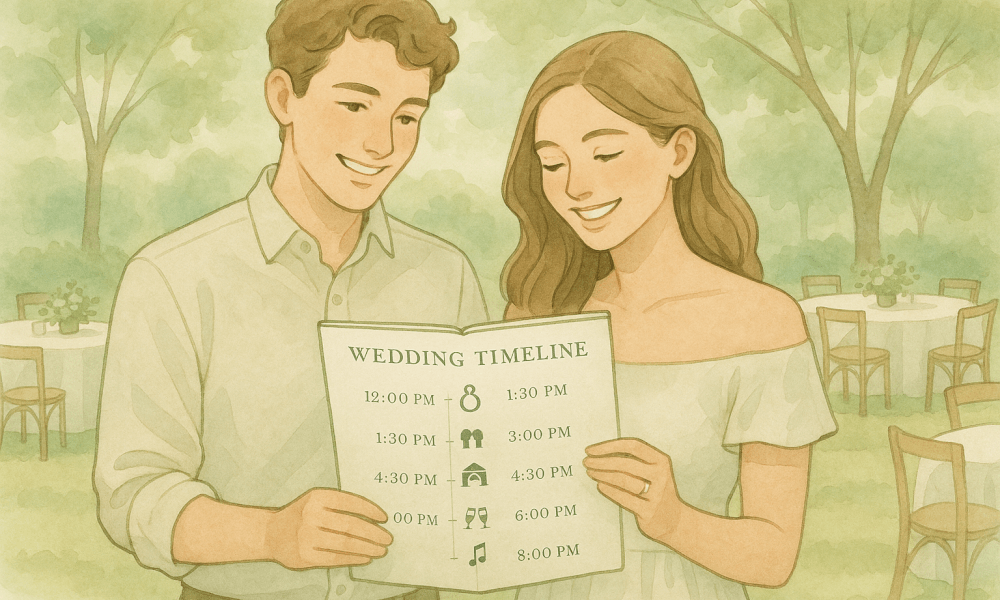Wedding Day: 7 Detailed Timelines for a Flawless Celebration

Making your wedding day a success is much more than a simple sequence of events: it’s about creating a smooth, harmonious moment that reflects who you are, in complete serenity. To ensure this experience meets your expectations (and at the very least stays stress-free), good organization is the key.
From choosing the type of ceremony and adjusting the timetable to coordinating vendors and managing the main moments, every detail matters to turn this date into an unforgettable memory. In this article, discover concrete tips, ready-to-use schedules, and practical tricks to build, step by step, the ideal script for your union. Let’s start with the fundamentals of organization to lay down solid foundations from the outset.
How to successfully organize your wedding day?
How to organize the flow of a wedding day: key steps and advice
Organizing a wedding day begins with careful planning of the key steps and the wedding schedule. First set the date and the type of ceremony—civil, religious, or secular. Establish a clear budget to guide your choices of venue and vendors. This foundation will help you prioritize what matters without getting sidetracked.
Create your guest list and a detailed wedding timeline: book the venue 12 months in advance, pick the dress 6 months before, finalize the seating plan one week prior. On the big day, start with a light breakfast during preparations. Delegate tasks to your witnesses and trusted loved ones to ease the day’s flow. Allow 20 to 30 minutes of buffer in your schedule to absorb delays. After the ceremony, follow up with the photo session, the cocktail reception, then the meal. This rigorous planning ensures a smooth and memorable progression of events.
Pros and cons of a daytime wedding without an evening party
This format has specific advantages and constraints to consider when planning your wedding day and organizing the schedule. Before making your decision, weigh these elements according to your priorities and your guests.
Advantages:
- Relaxed, informal atmosphere that encourages family interaction during the celebrations
- Savings on lighting and some nighttime decorations
- Full daytime entertainment options: outdoor activities and games
- Less stress and fatigue than a late-night event
- Generally lower budget compared with traditional receptions that include an evening party
Disadvantages:
- Missing the magical nocturnal atmosphere—if your wedding is at 2 p.m., what to do afterward becomes a central question
- Weather constraints requiring backup plans for outdoor activities
- Guests may tire after a long day of celebrations
- Limited lighting effects and cozy, dimmed atmospheres in the daytime schedule
Practical tips to optimize wedding timing and schedule
These organizational tips will help you structure your wedding day efficiently and define the key moments. They provide a simple method to keep time under control on the big day.
- Start from the ceremony time: for a wedding scheduled at 11 a.m., first fix the town hall or church time because it determines the entire ceremony and reception schedule
- Plan backwards from the ceremony time to organize preparations and transfers in your wedding timeline
- Allow 10 to 15 minutes between each step for optimal time management
- Estimate durations accurately:
- Makeup and hair: 1h30 to 2h depending on complexity
- Getting dressed: 15 to 30 minutes
- Couple photos: at least 45 minutes
- Share the detailed schedule with your witnesses and vendors one month in advance—some guests may even need to take a day off for a sibling’s or parent’s wedding
- Use planning tools: Excel sheets or wedding planning apps to centralize information and create your ideal typical wedding day
Logistical organization specific to a daytime wedding
Successful logistics on the wedding day depend on anticipating practical elements. Choose a venue suitable for your guest count and accessibility, especially if you’re planning a daytime wedding without a late-night party.
Coordinate your vendors—caterer, photographer, DJ, florist—through preliminary meetings to synchronize their contributions throughout the celebrations. Arrange guest transportation with shuttles and clear access information, keeping in mind that some may be traveling from far away.

Delegate day-of coordination to a wedding planner or coordinator who will oversee deliveries, setups, and handle unforeseen issues throughout the day. Setting up equipment and personal decorations requires careful preparation—consider hiring an assistant. This meticulous organization ensures a smooth flow for your daytime celebration, whether it’s a classic wedding or, for the more original, an homage to the spirit of Folle Journée or The Marriage of Figaro. Once these basics are in place, it’s easier to adapt your schedule to real constraints.
Detailed schedules for a successful wedding day
Schedule examples for a daytime wedding without a late-night party (morning, noon, afternoon)
Defining the key steps of your organization allows you to explore concrete schedules adapted to different times of day. A morning wedding with an 11 a.m. ceremony starts preparations at 8 a.m., including hair and makeup, followed by the civil ceremony and a convivial brunch around 12:30 p.m.
Couples often prefer a buffet or seated meal until around 2 p.m., then relaxed afternoon activities for those who choose a daytime-only format. For a noon ceremony, the cocktail reception naturally continues until about 3:30 p.m. with a garden-party-style lunch, creating a relaxed atmosphere for the day’s program.
The day is arranged differently for a 2 p.m. ceremony: deciding what to do after a 2 p.m. wedding becomes easy with a cocktail from 3 p.m. to 5 p.m., a seated dinner until 9:30 p.m., and a moderate dance afterward. These times can be adapted according to local constraints and the season, while sometimes saving on rental and catering costs, and echoing the festive spirit of Folle Journée or The Marriage of Figaro.
Typical schedule for an 11 a.m. wedding
Organizing an 11 a.m. wedding follows a precise, structured example schedule to ensure the day runs smoothly.
- 8:00 — Start of preparations: hair, makeup and dressing of the couple, with initial photos of details (dress, jewelry).
- 9:30 — Departure for the town hall allowing for travel time and possible photo stops, a crucial element of the wedding agenda.
- 11:00 — Civil ceremony lasting about 20 minutes, followed by 30 minutes for congratulations and photos on the steps—an important moment when family and friends (some of whom may have taken time off for a sibling’s or parent’s wedding) gather.
- 12:00 — Travel to the reception venue with a buffer of 30 minutes to 1 hour depending on the distance, an integral part of the ceremony and reception timeline.
- 13:00 — Cocktail reception for 1h30 to 2h with refreshments and light daytime entertainment, including a photo session.
- 15:00 — Seated meal or buffet for 2 to 3 hours, including speeches and wedding activities between courses, following the planned timing.
- 17:30 — Opening of the dance with the first dance, followed by the cake and festivities suited to this daytime format.
- 19:00 — Continued moderate dancing with guests gradually leaving around 10 p.m., closing this successful wedding day schedule.
Typical schedule for a 2 p.m. wedding
- Relaxed morning: wake up at 8 a.m., a leisurely breakfast, start preparations at 9 a.m. with 2h30 allocated to hair, makeup and getting dressed according to the established wedding timetable.
- Official ceremony: leave at 1:15 p.m. for a 30-minute civil ceremony at 2 p.m. at the town hall, in keeping with the event schedule.
- Optimal photo session: 1h30 of couple and group photos between 2:30 and 4:00 p.m., taking advantage of the ideal natural light for this typical wedding day.
- Sociable cocktail: 2-hour cocktail reception with hors d’oeuvres and drinks, allowing guests to mingle within the day’s entertainment.
- Evening meal: seating at 6 p.m., service until 11:30 p.m. with integrated entertainment like the “12 Months” game or speeches by the witnesses, following the wedding program.
- Night festivities: opening of the dance at 11:30 p.m. after the wedding cake, then a dance party according to your wishes and the established program.
How to manage the transition between the ceremony and the meal
Whatever time you choose, how you link the different moments makes all the difference for your guests. The logistical strategies shown in the schedules above require particular attention to key moments and transitions. The cocktail reception is the central pivot in managing wedding time, providing a decompression buffer after the formal ceremony while setting the tone for the meal.
Always plan 10 to 15 minutes of buffer to absorb delays and allow calm transfers—an essential wedding planning tip. During the 1 to 2 hour window, make the most of the photo session while guests enjoy the cocktail with light entertainment: quizzes, a caricaturist, or a photo booth keep interest high without overloading the schedule.
Coordination with your vendors ensures smooth sequencing: confirm times with the caterer, photographer, and DJ. A memorable entrance by the newlyweds into the reception room closes this transition on a festive note, announcing the start of the banquet in an already warm and relaxed atmosphere—an ideal conclusion to this stage of the wedding day timeline.

Choosing the venue according to the daytime format
Once your schedule and timings are set, choosing the venue becomes your top priority to bring your daytime wedding without an evening party to life. Capacity is the fundamental criterion: your space must comfortably accommodate all guests with enough room for the ceremony, the meal, and circulation.
A renovated longère farmhouse set in a large park, like La Demeure du Pont in Ille-et-Vilaine, for example, allows an outdoor ceremony followed by a cocktail in the garden, creating a harmonious wedding day flow. Versatile venues offer this valuable flexibility for organizing a daytime wedding.
Always check the site’s accessibility, especially for guests with reduced mobility, including suitable parking and transport options. Your budget directly affects your options: ask for comprehensive quotes that include hidden costs such as electricity, heating, and cleaning for better time and budget management. The culinary format should also match your daytime plan to strengthen the overall coherence.
Meal ideas and convivial formats for a daytime wedding
The daytime wedding format naturally favors lighter, more convivial meals than traditional evening dinners—perfect for a 2 p.m. wedding when you’re wondering what to do afterward.
- Friendly buffet: offer appetizer boards with farmhouse cheeses and artisanal charcuterie, accompanied by savory tarts, quiches, and salad bars to encourage choice and easily handle staggered arrivals within the wedding program.
- Dinner cocktail: serve canapés, verrines, mini-burgers and tapas for an elegant lunch where guests circulate freely without assigned tables, which greatly simplifies the ceremony and reception planning as well as the wedding timing.
- Summer barbecue: organize grills with meats, fish and vegetarian skewers accompanied by roasted vegetables to create an informal, outdoor-friendly atmosphere for the celebrations.
- Shareable dishes: set up long tables with paella, whole roasted meats, or giant tarts that create a warm, communal vibe among the key moments, with desserts served as a buffet such as tarts and fresh fruit.
- Themed food trucks: hire trucks offering crepes, burgers or ice cream to diversify options and simplify service during the day’s activities, especially if your outdoor space permits. These formats combine easily with smooth schedule management.
Tips to save money when organizing a wedding without an evening party
The lack of a late-night dance already represents substantial savings for a daytime wedding, but other strategies can further optimize your budget. Drastically limit your guest list to close family and friends, which will mechanically reduce food, drink, and rental costs during planning.
Choose an off-season date between November and April, or hold your celebration on a Friday to benefit from significantly lower rates—organizing a wedding at 11 a.m. can also be cost-effective. Unusual venues like private gardens, community halls, or family homes can greatly reduce rental fees while fitting your wedding agenda.
Favor DIY for digital invitations, decorations made from natural or recycled materials, and call on talented friends and family for simple wedding activities. This approach lowers costs while creating an intimate, personalized atmosphere, following organizational tips that value authenticity. The sequence of wedding events remains smooth and the day-of logistics simplified, producing a memorable wedding day flow that will be cherished. Then focus on polishing the overall atmosphere to enhance the experience.
Style and entertainment
Appropriate attire for a wedding held during the day
Choosing attire is crucial for a successful wedding day, especially for a daytime wedding without an evening party. Midi or short dresses are perfectly suited to daytime ceremonies—whether your wedding is at 2 p.m. and you’re wondering what to do afterward, these styles are simple and relaxed. They combine elegance with ease without being over the top.

Light fabrics like chiffon, cotton or tulle provide comfort and freshness during an outdoor ceremony. Summer colors—pastels, bright shades, or floral prints—add cheer to the wedding atmosphere.
For a country-style wedding with an 11 a.m. schedule, favor a flowing dress with flat or wedge sandals. A classic wedding calls for more structured attire: a midi dress or an elegant suit for a full wedding program. Men can opt for linen or cotton suits, often without a tie, perfect for the day’s flow. The venue heavily influences choices during preparations: breathable fabrics and appropriate shoes for outdoors, more structured outfits for indoor locations. By coordinating materials and cuts with the setting, you naturally harmonize the whole look.
Music and atmosphere: alternatives without a dance floor
Music can transform your daytime wedding organization without requiring a traditional dance floor, creating memorable daytime entertainment. These options encourage conversation and conviviality throughout the reception.
- Arrange a live concert with a jazz quartet during the meal, echoing the spirit of Folle Journée or The Marriage of Figaro, or a stripped-down acoustic duo for personalized covers
- Offer an interactive karaoke where the couple opens the entertainment by singing their favorite song before inviting guests to join
- Include musical games like team blind-tests with iconic film tunes or a themed music quiz in your wedding schedule
- Set up playful attractions: a photobooth with musical props, giant board games or group percussion workshops that enrich the wedding agenda
- Plan stage shows: magic, improv theater or humorous testimonials punctuate the ceremony and reception program
- Create an ambient playlist with jazz, classical music or international standards like “La Vie en Rose” by Édith Piaf to accompany the day’s timetable
- Organize a collective song where guests learn a symbolic piece together with a musician, creating unforgettable key wedding moments
Managing children and suitable activities
These musical entertainments fit naturally into the daytime wedding flow with activities specifically for the youngest guests. A dedicated kids’ corner with mats, cushions and toys lets little ones relax between the different moments of a typical wedding day. Children aged 3–6 will enjoy face painting, duck pond games and simple coloring workshops while their parents take time off for a parent’s or sibling’s wedding.
Children aged 7–12 will prefer a treasure hunt with clues, creative workshops like jewelry-making, or mini sports challenges that fit into the wedding timing. The sequence of events alternates outdoor games (giant hopscotch, sack races) and quiet activities (playful placemats, puzzles) according to the day-of logistics. Professional entertainers can supervise everything with face painting, balloon sculpture and managing kids’ mealtime. Plan several complementary activities following these organization tips: craft workshops, a mini-disco, a movie screening or a heart-shaped piñata. This variety ensures children stay occupied throughout the example daytime wedding schedule without boredom. By anticipating their rhythm, you offer parents a more relaxed experience.
Preparing your wedding day requires discipline, anticipation and a touch of creativity. With a well-thought-out program and a clear vision of the essential steps, you can orchestrate a smooth, warm celebration that reflects you.
Whether it’s an intimate daytime wedding, a no-evening-party formula, or a mix of ceremony and festive moments, every logistical choice helps make the event unique. By relying on the many time references, entertainment ideas and budget tips shared here, you’ll gain calm and enjoyment throughout the preparations.
The most important thing is to surround yourself with the right people, plan alternatives for unforeseen events, and above all design a celebration true to your desires. This moment of union will remain engraved in your memories—not by its perfection, but by the emotions, attentions and moments shared. Now it’s up to you to transform your vision into reality, at your pace and in your own way. And most importantly, enjoy every moment to savor the day you imagined.

Weddings


